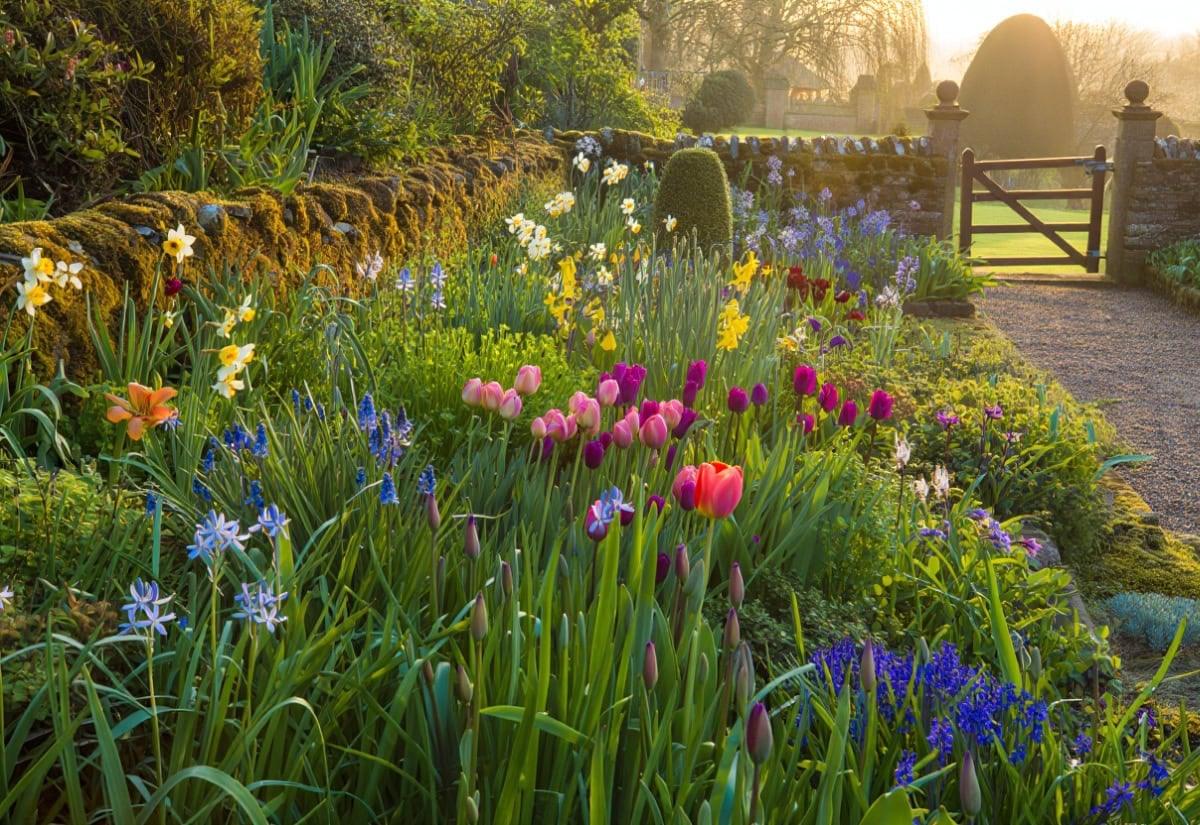
Every gardener knows the heartbreak of a short spring. One minute the tulips are glowing, the daffodils are dancing, and the next… it’s over. The petals drop, the leaves flop, and suddenly your beautiful border looks tired before the season has even begun.
I’ve been there. Most of us have. But here’s the thing—your spring garden isn’t broken. It’s just missing a little choreography.
Bulbs don’t have to bloom all at once. They’re not on some universal schedule. Some show up early—when March arrives, the first snowdrops push through the frost. Then come crocus. Then daffodils. Then tulips. Then alliums. The garden never goes quiet—it simply changes tempo. Some hold out until the last minute, and when you layer them well, you can turn a two-week flower fling into a full ten-week love story.
Plant with that progression in mind—layering varieties to stagger their bloom times (early, mid, and late)—and suddenly spring stretches out. What used to be a two-week cameo becomes a ten-week performance. No gaps. No lulls. Just a garden that shifts and surprises you, week after week.
So if your spring garden has ever gone from “wow” to “what happened?” in the blink of an eye—don’t worry. This fall is your chance to fix it. Plant these bulb combos this fall, and next year your garden won’t just pop—it’ll perform. Curtain up. No early exits. Just week after week of “wow.”
1. Snowdrops + Crocus + Dwarf Iris
Timeline: Late February to Late March
If you’ve ever looked out in late winter and wished for proof that spring is coming, this trio delivers it. Snowdrops, crocus, and dwarf iris can keep your beds in color for nearly six weeks—often before your neighbors have a single bloom.
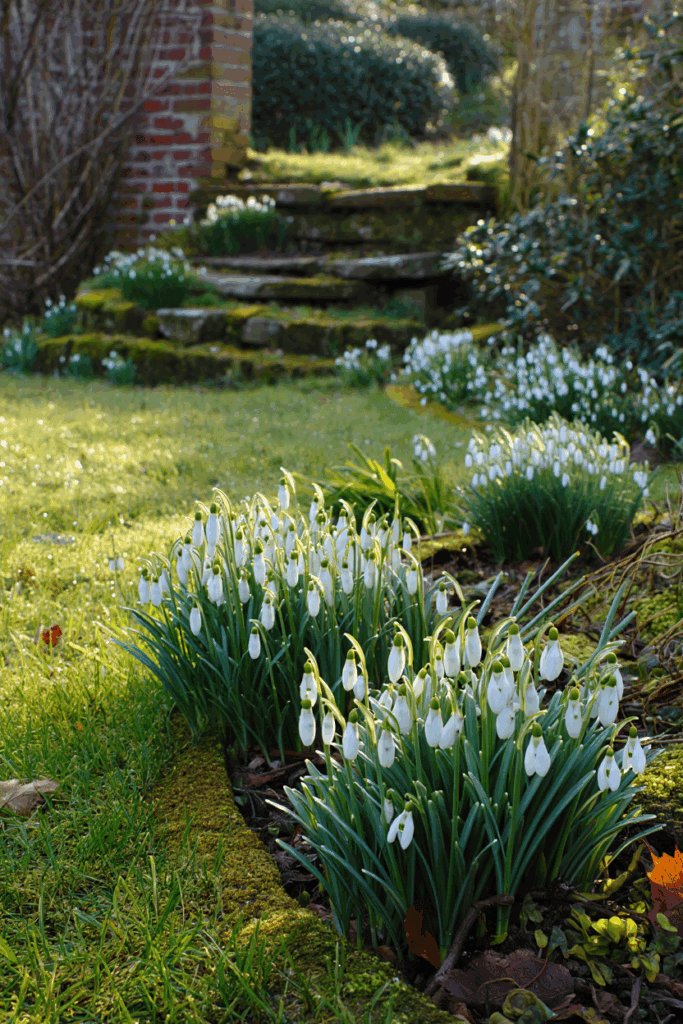
Snowdrops (Galanthus elwesii) are always the first to appear, usually when daytime highs are still hovering around 40°F. They push through frozen ground and even bloom through light snow. Each bulb sends up slender leaves and one graceful white flower, marked with a single green “tear” at the petal tip. They naturalize slowly but steadily, forming clumps that return reliably for decades in Zones 3–8.
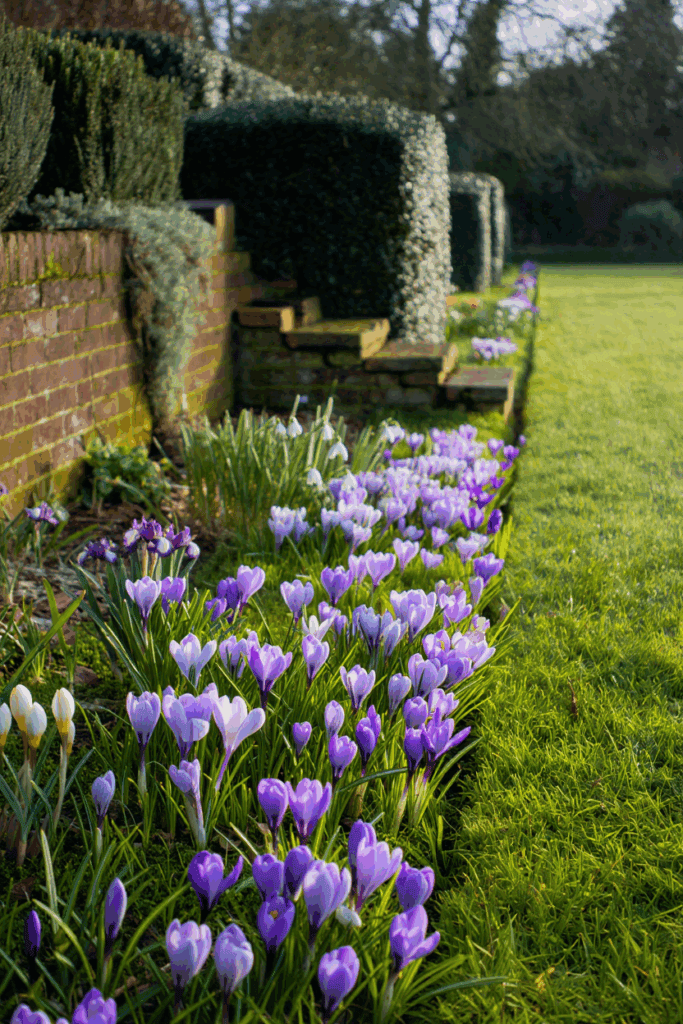
Within a week or two, Crocus tommasinianus takes over—lavender to lilac petals with silver sheen, often called “tommies.” They’re quick to spread, especially in gritty, well-drained soil. A sunny patch near a path or lawn edge works best; they bloom strongest when they catch full sun for at least part of the day. Bees rely heavily on these crocus for early nectar, especially on mild March afternoons.
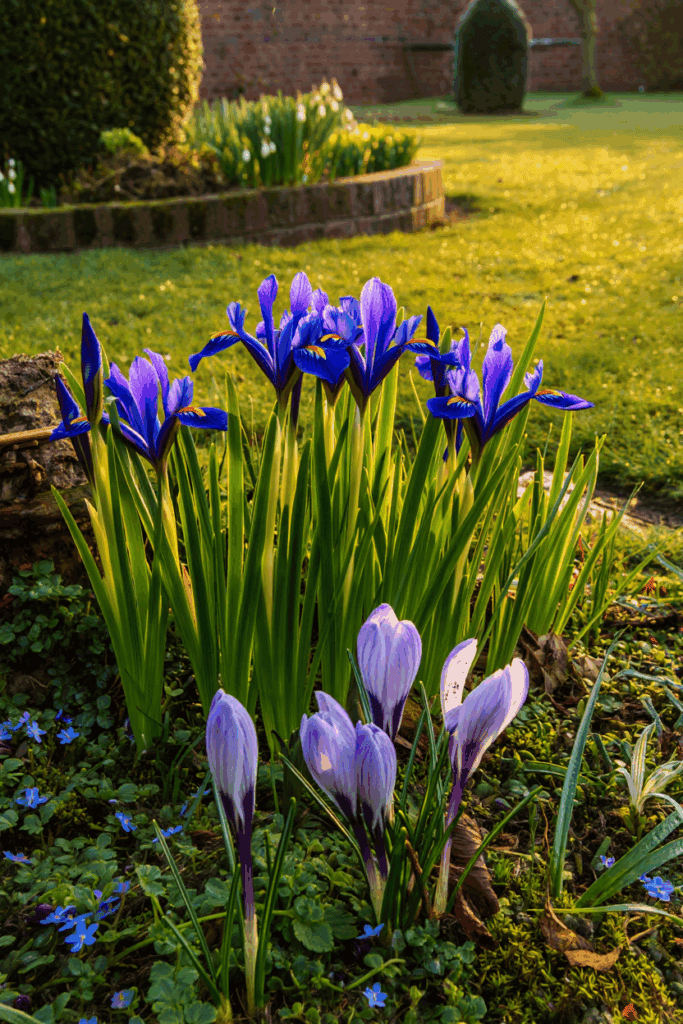
Then, right as the crocus fade, Iris reticulata ‘Harmony’ begins. Deep blue-violet petals streaked with gold add a burst of color that bridges into mid-spring. These irises prefer the same conditions—dryish soil that warms early—and look especially striking planted near rocks or stone steps where heat radiates back to the roots.
Plant bulbs in fall once soil cools to around 55°F—usually October in Zones 4–7 and November in Zones 8–9. Choose well-drained soil and full sun to part sun. In most gardens, this combination will bloom from the last week of February into late March, carrying your landscape through that quiet gap before daffodils and tulips take over.
2. Winter Aconite + Siberian Squill + Grape Hyacinth
Timeline: Early March to Mid-April
If the first combo whispers that spring is coming, this one announces it loud and clear. These three bulbs—winter aconite, Siberian squill, and grape hyacinth—turn bare soil into a living carpet of gold and blue just as the world starts to green up.

Winter aconite (Eranthis hyemalis) is always the first to bloom, often when frost still lingers in the shade. Its buttercup-yellow flowers open wide on sunny days and close again at night, creating a cheerful glow against last year’s leaves. Aconites spread slowly by seed and thrive best under deciduous trees where they catch full sun before the canopy fills in.

A couple of weeks later, Siberian squill (Scilla siberica) begins to flower, dotting the ground with intense cobalt blue. They multiply readily, seeding themselves into lawns, rock gardens, or woodland edges without becoming pushy. Each tiny bell nods toward the ground, catching sunlight like drops of sky. Bees adore them on those first truly warm days of March.
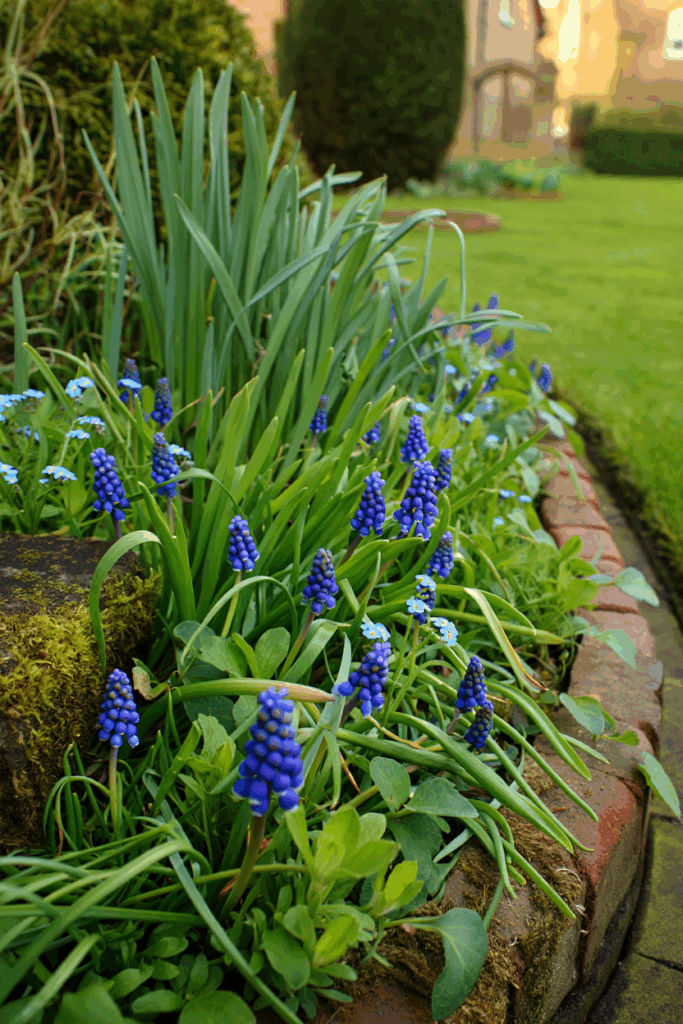
To finish the sequence, grape hyacinths (Muscari armeniacum) bring structure and fragrance in early to mid-April. Their clusters of deep violet-blue blooms last for weeks and look striking woven through fading squill foliage. Muscari handle heavier soils than most bulbs and are among the few that reliably return in clay, making them a dependable end note to the early-spring show.
Plant this trio in well-drained but moisture-retentive soil, ideally in full to part sun. In Zones 4–7, plant in mid to late October; in Zones 8–9, wait until November when soil cools. Together, they’ll blanket your beds in color for nearly five weeks—starting with yellow, then shifting to waves of blue, and ending with rich violet—a perfect slow-motion crescendo from winter to spring.
3. Daffodils + Tulipa kaufmanniana + Darwin Hybrid Tulips
Timeline: Mid-March to Early May
If you want that long, seamless spring display that looks professionally planned, this trio delivers. It begins gentle and golden, then deepens into the bold, painterly tones that define late April gardens.

Start with early daffodils—choose varieties like ‘Jetfire’ (bright yellow with an orange trumpet) or ‘February Gold’ (lemon-yellow and classic). They bloom as soon as the soil warms to the mid-40s and shrug off late frost and rain. Daffodils naturalize easily, so each year you’ll see more clusters lighting up the beds.

Just as their color starts to fade, Tulipa kaufmanniana—often called waterlily tulips—open like little stars. Try ‘Showwinner’ in scarlet, ‘Concerto’ in creamy white, or ‘Ancilla’ with ivory petals edged in rose. They stay low and tidy (6–8 inches tall) and love the same sunny, well-drained spots as daffodils.

Then, as April deepens, the Darwin Hybrid Tulips rise above everything—tall, graceful, and generous in bloom. Varieties like ‘Pink Impression’, ‘Oxford’ (classic red), or ‘Ollioules’ (rose pink fading to silver) keep the garden vivid well into May. They’re among the few large tulips that perennialize for several years if planted in a sunny, dry summer site.
Plant the bulbs together in full sun and well-drained soil, about 6–8 inches deep, once the soil cools to roughly 55°F—October in Zones 4–7, November in 8–9. The payoff is a color run that begins in soft yellow, shifts through coral and cream, and ends in bold reds and pinks—a full ten weeks of spring energy in one bed.
4. Glory-of-the-Snow + Early Tulips + Late Tulips
Timeline: Early April to Mid-May
This combination delivers that magazine-worthy spring border—one that feels effortless but unfolds in perfect rhythm. It starts low and soft, builds into color, and finishes with drama.

Glory-of-the-Snow (Chionodoxa forbesii) opens the show in early April, spreading a delicate carpet of sky blue and white stars just as the ground begins to warm. They naturalize beautifully, filling in around shrubs and the base of taller bulbs without ever becoming messy.

Next, the Single Early Tulips—try ‘Purple Prince’ for a deep plum tone or ‘Apricot Beauty’ for warm peach-pink—step in to bridge the season. They bloom low and compact, holding up even in windy spots, and pair beautifully with the fading Chionodoxa beneath.

Finally, the Single Late Tulips bring the finale. ‘Queen of Night’, with its near-black petals, and ‘Maureen’, a creamy ivory white, extend the color show into mid-May. The tall stems and glossy blooms create striking silhouettes at dusk and in morning light.
Color cue: Stick to one tonal family—like pink to plum or cream to yellow—for a coordinated, designer look that reads intentional rather than patchy. Plant in full sun with well-drained soil once temperatures drop to 55°F (October for Zones 4–7, November farther south).
This mix stretches the tulip season from early April through mid-May—nearly six weeks of evolving color that keeps your garden feeling fresh and cohesive right to the end of spring.
5. Mini Daffodils + Species Tulips + Alliums
Timeline: Mid-April to Late May
If you love a garden that never looks tired between early spring and summer, this is the combo that keeps the color rolling. It starts bright and cheerful, then slowly turns elegant and architectural—without you lifting a finger.

First come the mini daffodils (Narcissus ‘Tête-à-Tête’)—those tiny golden trumpets that make even a gray April morning feel warm. They’re short, sturdy, and always reliable. Plant them once, and they’ll return every year like clockwork, spreading into friendly clusters along paths and borders.

As the daffodils begin to fade, the species tulips take over—Tulipa clusiana with its pink-and-white petals that open wide in sunlight, and T. tarda with yellow stars edged in ivory. These little tulips don’t behave like the big, short-lived hybrids; they come back year after year and even multiply if the soil drains well. Their smaller scale gives beds that soft, natural look—like color spilling through wild grass.

And just when you think the show is done, Allium ‘Purple Sensation’ rises above everything with tall, violet globes that seem to float over the garden. They arrive in May, right as the tulips fade, pulling your eye upward and giving structure just when early perennials are starting to grow in. Bees adore them—you’ll hear that low hum every warm afternoon.
Plant the bulbs in full sun with well-drained soil once it cools in fall—October in cooler zones, November farther south. Together, they’ll give you a continuous six to seven weeks of bloom, carrying your garden smoothly from the golden tones of April into the lush purples of May.
6. Hyacinths + Midseason Tulips + Camassia
Timeline: Mid-April to Late May
If you like your spring garden to smell as good as it looks, this trio is hard to beat. Hyacinths bring the fragrance, tulips bring the color, and camassia adds that graceful, natural touch that keeps things from feeling too staged.

It starts with hyacinths (Hyacinthus orientalis)—the classic spring perfume. Try ‘Carnegie’ for clean white, ‘Pink Pearl’ for soft blush, or ‘Delft Blue’ for that signature sky tone. They bloom just as the weather turns mild, filling the air with scent that travels on a breeze. For a more natural look, plant them in loose clusters instead of tight rows—they’ll still make an impact without feeling formal.

A week or two later, the midseason tulips come into their stride. Varieties like ‘Pink Impression’, ‘Golden Parade’, or ‘Don Quichotte’ overlap perfectly with the fading hyacinths. Together they create that full, layered look—color and fragrance mingling while the rest of the garden is just waking up.

Then, as May deepens, Camassia leichtlinii takes over. Its tall spires of starry blue or ivory flowers rise through the fading tulip foliage, catching the late-spring light. Unlike tulips or hyacinths, camassia is a true North American native bulb—it thrives in heavier, moist soils and comes back stronger every year. It’s also one of the best late-spring nectar sources for bees.
Plant all three in full to part sun, spacing them in small drifts through borders or naturalized areas. Hyacinths and tulips prefer well-drained soil, while camassia tolerates more moisture, so place it just beyond the drier edges of your bulb bed. In Zones 4–7, plant in October; in 8–9, wait until November when the soil cools.
7. Daffodils + Fritillaria meleagris + Allium sphaerocephalon
Timeline: Early April to Late May
If you love a spring garden that never flatlines between bloom cycles, this trio keeps the rhythm going—from bright gold to moody plum to deep, bee-magnet purple.

Daffodils (Narcissus spp.) start first, with dependable midseason types like ‘Ice Follies’ or ‘Carlton’. They shine in early April when nights are still chilly and look best in generous clumps where they can naturalize over time.

Then comes Fritillaria meleagris, the snake’s head fritillary, with its elegant checkered bells in purple and white. It thrives in cool, moist spots—beneath trees or along the edge of a lawn—and adds a soft, woodland texture that pairs beautifully with fading daffodils.
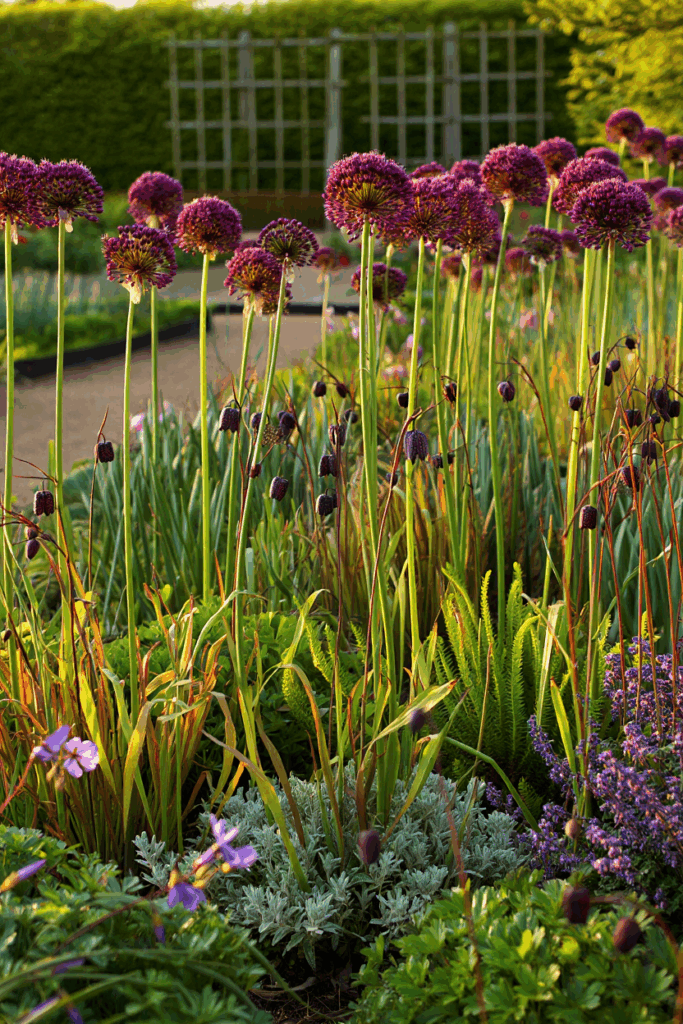
By late May, Allium sphaerocephalon—the drumstick allium—takes over, sending up slender stems topped with rounded, burgundy-purple blooms that sway above everything else. They bridge spring into summer effortlessly and attract pollinators nonstop.
Plant all three in fall once soil cools to about 55°F—typically October in Zones 4–7 and November in Zones 8–9. Choose full sun and well-drained soil, with the fritillaries tucked slightly deeper where moisture lingers in spring.
Together, they create an unbroken display that evolves for nearly eight weeks—sunny, subtle, then striking—all from one fall planting.
8. Wild Tulips + Spanish Bluebells + Ornamental Onion
Timeline: Mid-April to Early June
If you want a spring border that looks natural, layered, and effortless, this trio is a perfect choice. It moves from jewel-bright to airy and architectural, carrying color well into early summer.

It starts with wild tulips (Tulipa sylvestris or T. bakeri ‘Lilac Wonder’)—graceful, perennial species with slender stems and star-shaped blooms in golden yellow or lilac-pink. They open wide in sunlight and close at dusk, weaving through the border with a light, meadowy feel. Unlike show tulips, they come back reliably every year if the soil drains well.

As the tulips begin to fade, Spanish bluebells (Hyacinthoides hispanica) take over. Their arching stems and clusters of blue, pink, or white bells fill the mid-spring gap beautifully, naturalizing into drifts under trees or along fences. They’re tougher than English bluebells and tolerant of both sun and part shade, making them easy companions for tulips.

Finally, ornamental onions (Allium ‘Globemaster’ or A. cristophii) rise in late May, sending up bold, spherical blooms in shades of lilac and violet. Their tall stems and globe-shaped flowers add structure and a sense of height just as the bluebells finish. They’re drought-tolerant once established and adored by bees.
Plant all three together in well-drained soil and full to part sun once the ground cools to around 55°F—October in Zones 4–7, November in 8–9. Space the tulips and bluebells in loose drifts for a naturalized effect, with alliums tucked slightly behind for vertical drama.
9. Anemone blanda + Triumph Tulips + Bearded Iris
Timeline: Late March to Early June
This trio feels like a classic painting come to life—low blue brushstrokes, a sweep of color in the middle, and tall, elegant lines to finish. It’s graceful, balanced, and quietly showy in all the right ways.

It starts with Anemone blanda ‘Blue Shades’, those small, daisy-like blooms that cover the ground in early spring. They open with the first real warmth of March, catching sunlight like bits of sky fallen to the soil. Once planted, they naturalize easily, returning year after year to fill the base of borders or tree lines with soft color and texture.

A few weeks later, Triumph tulips take over. These are the dependable midseason workhorses that stand strong in wind and rain. ‘Ballerina’ glows a fiery orange with a hint of fragrance, while ‘Mistress’ brings a silky rose-pink elegance. Together they light up the garden when the anemones fade, carrying the energy into May.

And then, when the tulips finally drop their petals, Bearded iris (Iris germanica) takes the stage. Their tall, architectural stems and ruffled blooms add instant drama. Choose colors that echo your tulips—deep plum with pinks, or soft apricot with oranges—for a seamless handoff of tone.
Plant everything in full sun and compost-enriched, well-drained soil once fall temperatures dip below 55°F (October for cooler zones, November farther south). The anemones will settle in low, the tulips in the middle layer, and the irises behind them.

Written By
Amber Noyes
Amber Noyes was born and raised in a suburban California town, San Mateo. She holds a master’s degree in horticulture from the University of California as well as a BS in Biology from the University of San Francisco. With experience working on an organic farm, water conservation research, farmers’ markets, and plant nursery, she understands what makes plants thrive and how we can better understand the connection between microclimate and plant health. When she’s not on the land, Amber loves informing people of new ideas/things related to gardening, especially organic gardening, houseplants, and growing plants in a small space.
